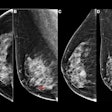Women with physical and cognitive disabilities face significant challenges in breast cancer diagnosis and treatment access, according to findings published November 13 in JAMA Network Open.
Researchers led by Dong Wook Shin, MD, PhD, from Sungkyunkwan University in Seoul, South Korea, found that compared to women without disabilities, those with disabilities are more likely to have distant staging and worse survival outcomes and are less likely to undergo timely treatment.
“These findings suggest that interventions addressing disability-related barriers are urgently needed to achieve equitable breast cancer care,” Shin and colleagues wrote.
The team noted that most studies based in the U.S. define disability using the Medicare and Social Security Disability Insurance definition. This excludes working individuals and overlooks differences in insurance coverage, the team highlighted. The researchers also noted that age restrictions and the lack of chemotherapy data or consideration of disability severity can further limit generalizability.
Shin et al studied disparities in the diagnosis, treatment, and survival outcomes of breast cancer patients and disability compared with patients without disabilities. South Korea uses a universal health insurance system that covers all individuals. The investigators used data collected between 2012 and 2019 from the Cancer Public Library Database and the Korean National Disability Registration System. It included women with medically verified disabilities, including physical, brain, and sensory impairments.
The research included data from 150,412 women with breast cancer, of whom 7,442 (4.9%) had a disability. The group reported that women with disabilities were more likely to be aged 65 years or older (41.2%) compared with women without disabilities (14.1%). Women with disabilities in the study were also more likely to receive a distant or unknown diagnosis.
Comparison between breast cancer patients without and with disabilities | ||
Measures | Without disabilities | With disabilities |
Distant diagnosis | 4.6% | 6.8% |
Unknown diagnosis | 2.5% | 4.1% |
The team also found that women with disabilities were less likely to undergo surgery (adjusted odds ratio [aOR] 0.91), receive chemotherapy (aOR, 0.77), or receive radiotherapy (aOR, 0.85).
“The disparity was most pronounced for patients with severe brain impairments,” it noted.
Finally, women with disabilities had higher overall mortality, with an adjusted hazard ratio (aHR) of 1.59. Women with severe disabilities had a higher overall mortality aHR of 2.15.
The results highlight the need for a multidisciplinary approach to postoperative care, the study authors wrote. This may include improving patient education, providing caregiver support, and monitoring high-risk women more.
“Most excess mortality was attributed to breast cancer, highlighting that unequal access to standard care substantially contributes to survival disparities,” they noted.
An integrated approach could help improve how health systems address the needs of women with disabilities, according to an accompanying editorial written by Danish Ahmad, MBBS, PhD, and Rafat Hussain, MBBS, PhD, from Australian National University in Canberra.
"Although systems-level changes in healthcare take time and resources, they are more sustainable and cost-effective in the long run, with improvements in clinical outcomes through early detection and appropriate management of these conditions," the two wrote.
Read the entire study here.




















